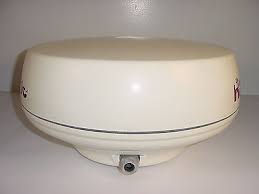
a company implementing and testing networked robots
- Three RRTransformer units: an Internet gateway, a surface mobile station and a lightweight UAV station were demonstrated at ACM CarSys 2017 on October 20th, 2017. Here is the demo poster "Radio Rate Transformer: A Portable VHF/UHF and Gigahertz Radio Combo Providing Broadband Ad-hoc Networking Services to Mobile Vehicles".
- An RRTransformer prototype system was demonstrated at ACM WUWNET the 11th International Conference on Underwater Networks & Systems, Oct. 2016. Here is the demo poster.
We provide real-time vehicular better-than-5G surrogate system, a complete bundle of broadband communication equipments to build surface-based non-satellite real-time vehicular broadband network at anywhere and anytime. Here the term "vehicle" refers to surface vehicles such as automobiles, boats, ships, as well as aerial vehicles such as UAVs, airplanes, helicopters, etc. These vehicles act as networked robots if equipped with our system.
Why not SatCom (satellite communication)?
In regard to remotely-controlled robots (e.g., vehicules under autonomous driving), it is inappropriate to use satellite communication because of its super-long propagation delay. The diagram below shows the reason why there is no satellite communication system can achieve one-way delay in less than 2 milli-seconds and round-trip time (RTT or ping delay) in less than 4 milli-seconds. Due to different traffic conditions, satellite communication may be appropriate in controlling military UAVs, but is dangerously slow in controlling automobiles on the ground roads.- Mobility concerns: The phased array antenna used in SatCom devices, such as SpaceX's Starlink terminals, is not robust against vehicular shaking when aligning its beam-forming towards satellites. If the underlying vehicle is constantly shaking, the quality of SatCom links is not guaranteed. An empirical proof is that SpaceX's Starlink prohibits in-motion usage in its Term-of-Service contract from the very beginning, and a mandatory firmware update of its "dishy" terminal issued in late 2022 automatically disconnects at speeds above ~10mph, and reconnects when the vehicular speed drops below that.
- Real-time concerns: In regard to remotely-controlled robots (e.g., vehicules under autonomous driving), it is inappropriate to use satellite communication because of its super-long propagation delay. The diagram below shows the reason why there is no satellite communication system can achieve one-way delay in less than 2 milli-seconds and round-trip time (RTT or ping delay) in less than 4 milli-seconds. Due to different traffic conditions, satellite communication may be appropriate in controlling military UAVs, but is dangerously slow in controlling automobiles on the ground roads.
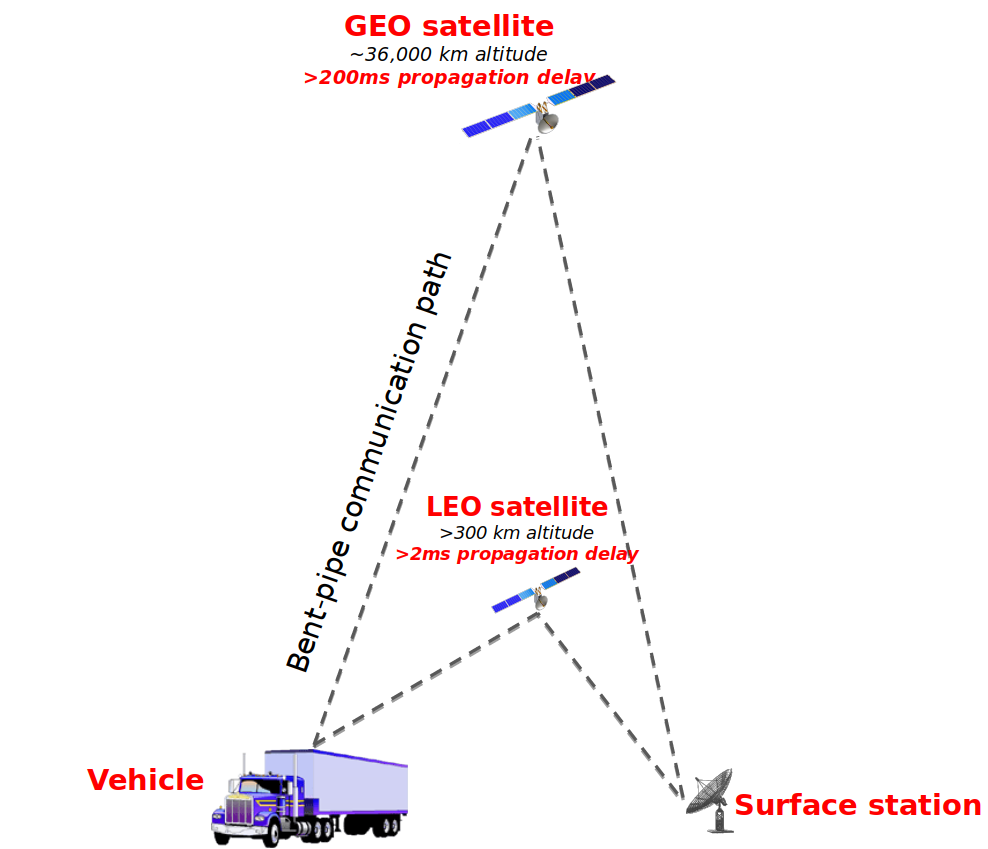
Why not satellite communication for vehicular robots? Too much delay
On the contrary, our non-satellite better-than-5G surrogate system features direct communication path with less than 0.1 milli-second propagation delay. We enable a communication solution that can control surface vehicles in less than 2 milli-seconds network delay (the current RTT/ping delay of our system is as fast as 1 milli-second), thus make autonomous driving safer.
| Throughput bit rate | Typical 5G metric | Typical RRTransformer better-than-5G metric |
|---|---|---|
| at 20 meter | 1Gbps | 200Mbps |
| at 500 meter | 100Mbps | 100Mbps |
| at 1km | 0 (broken link) | 50Mbps |
| at 14km | 0 (broken link) | 8Mbps |
The Solution Overview
We provide broadband communication service to surface vehicles (automobiles, boats, ships) as well as aerial vehicles (UAVs, airplanes, helicopters) at anywhere anytime with the following patented products:- real-time 5G surrogate base staion: Tetherless & wireless unmanned ground fixed stations running completely on green power (solar and wind), without the need of utility power lines and wired fiber optical cables. With a 10-sqft ground lot and a less-than-$5000 one-time low-cost installation fee, every tetherless fixed station can cover up to 50 miles in radius and provide up to 1Gbps wireless linkspeed. All you need to do is to replace the off-the-grid battery every 5 years, solar panel every 15 years and wind turbine every 20 years.
- real-time 5G surrogate vehicular router units that can provide moving vehicles at 8km to 30km distance with 10Mbps to 200Mbps broadband link speed, or at shorter distance with Gbps link speed.
- AI-assisted remote robots that can do automated operations when human is not in the control loop, or are remotely controlled by human-in-the-loop through the broadband network service we have provided. Currently our deep-learning AI modules are based on Caffe and OpenCV.
Category 1: Long-distance wireless broadband networks:
We own a patented FCC-compliant unique beam-forming vehicular communication technology (RRTransformer) to implement high-speed broadband wireless links for fast-moving vehicles at long-distance. Our technology is applicable to any omni-directional and imprecise directional communication devices to achieve optimal communication performance:- Real-time capability. Compared to Elon Musk's futuristic Starlink (LEO satellite based broadband networks) which will cause at least 2 milli-seconds of one-way propagation latency, our broadband networks feature minimal propagation latency measured in micro-seconds. Given the fact that Starlink's one-way propagation latency is at least 20-times larger than ours, Starlink fails but we can deliver real-time robot operations, because the round-trip latency from the controller to the remote robot then back to the controller must be less than 10 milli-seconds in real-time applications.
- Increasing single-hop transmission range by 50% to 1000%. For example, for WiFi or WiMax devices, we increase DJI Lightbridge's omni-directional 1.7km transmission range to 17km with the same MBps broadband bandwidth settings under the FCC 36dBm EIRP restrictions for moving vehicles.
- Decreasing signal error rate by 50% or more. As our beam-forming technologies concentrate signal radiation energy towards a narrow region, the signal-to-noise ratio is much improved, so that the receiver experiences a significantly decreased error rate.
- Reducing probability of signal detection by an order of magnitude. Our beam-forming technologies also achieve low-probability interception (LPI) by an order of magnitude, e.g., an order comparable to 36:1.
With the help of this enabling technology, video+audio data collected on drones are fed back at real time to human-in-the-loop control center to support avant-garde applications such as unmanned navigation/driving. The very same technology can also provide long-distance wireless Internet for ships, boats, yachts along the coastline.
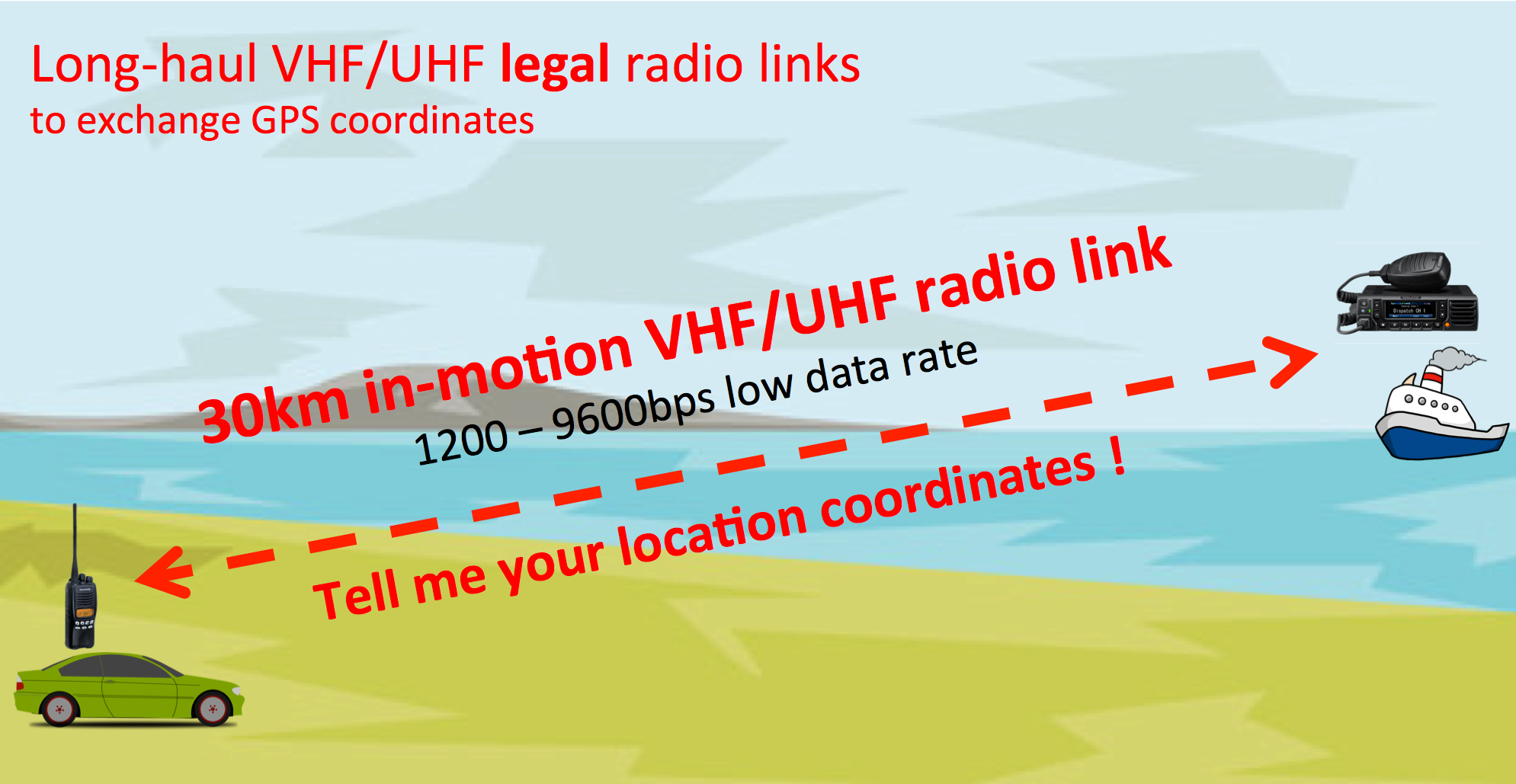
then:
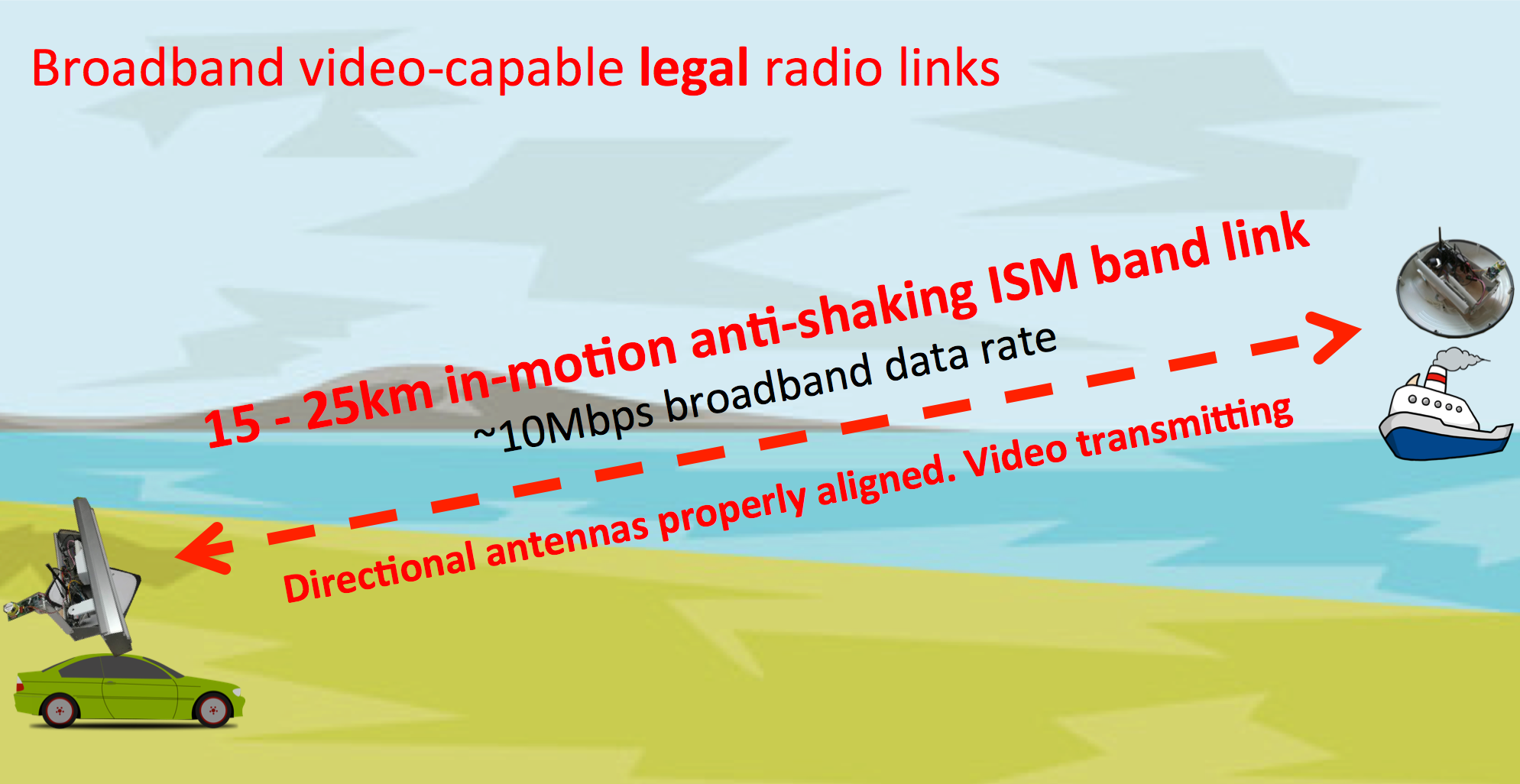
Caveats: In a non-FCC-regulated location, for example, in the middle of
the Pacific ocean with no nearby inhabited islands, we can increase the transmission
range from 25km to 60km simply by increasing the radio transmission power.
Category 2: Tetherless green-power ground fixed stations:
We use a combo of 100-watt solar power panel and 300-watt wind turbine to establish our broadband network ground fixed stations at anytime and anywhere, for example, on boats, buoys, mountain tops, high desert lands. In our southern California lab, our average tetherless fixed-stations are fully functional 95% of the time (i.e., ~346 days annually) merely on solar power and wind power, without consuming any power from Southern California Edison or Arizona Public Service Electric.Category 3: AI-assisted robotic systems deployed at remote sites are controlled by human-in-the-loop via broadband wireless networks
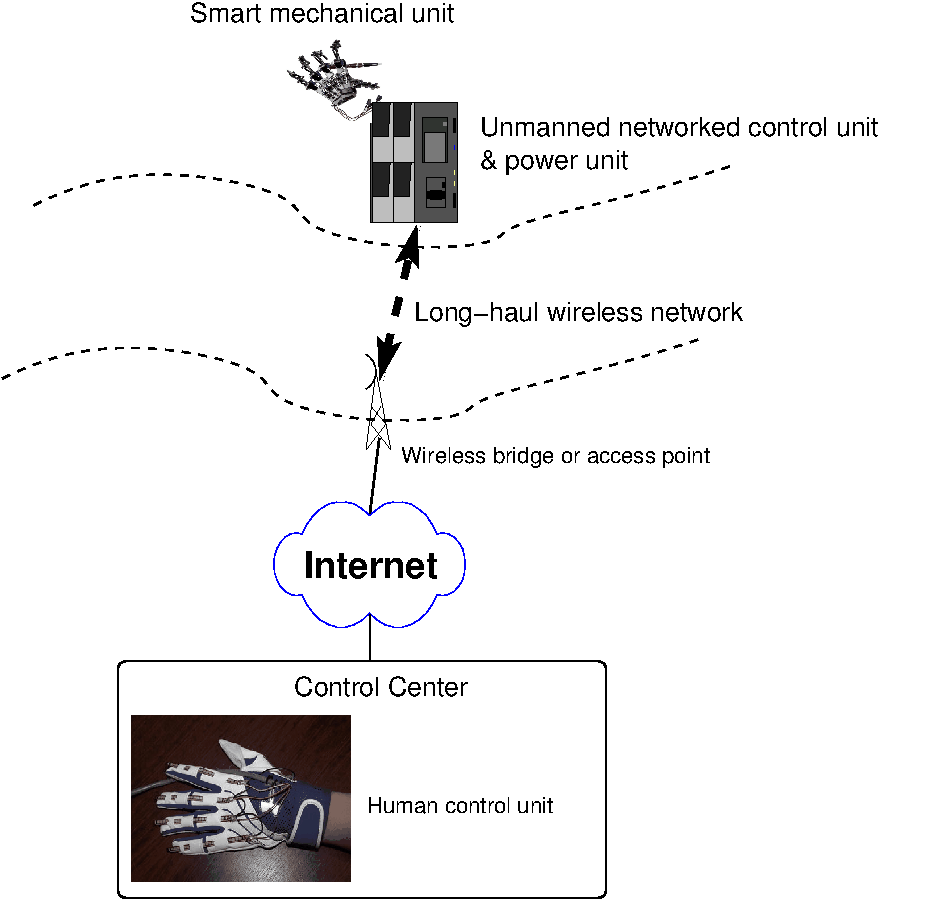
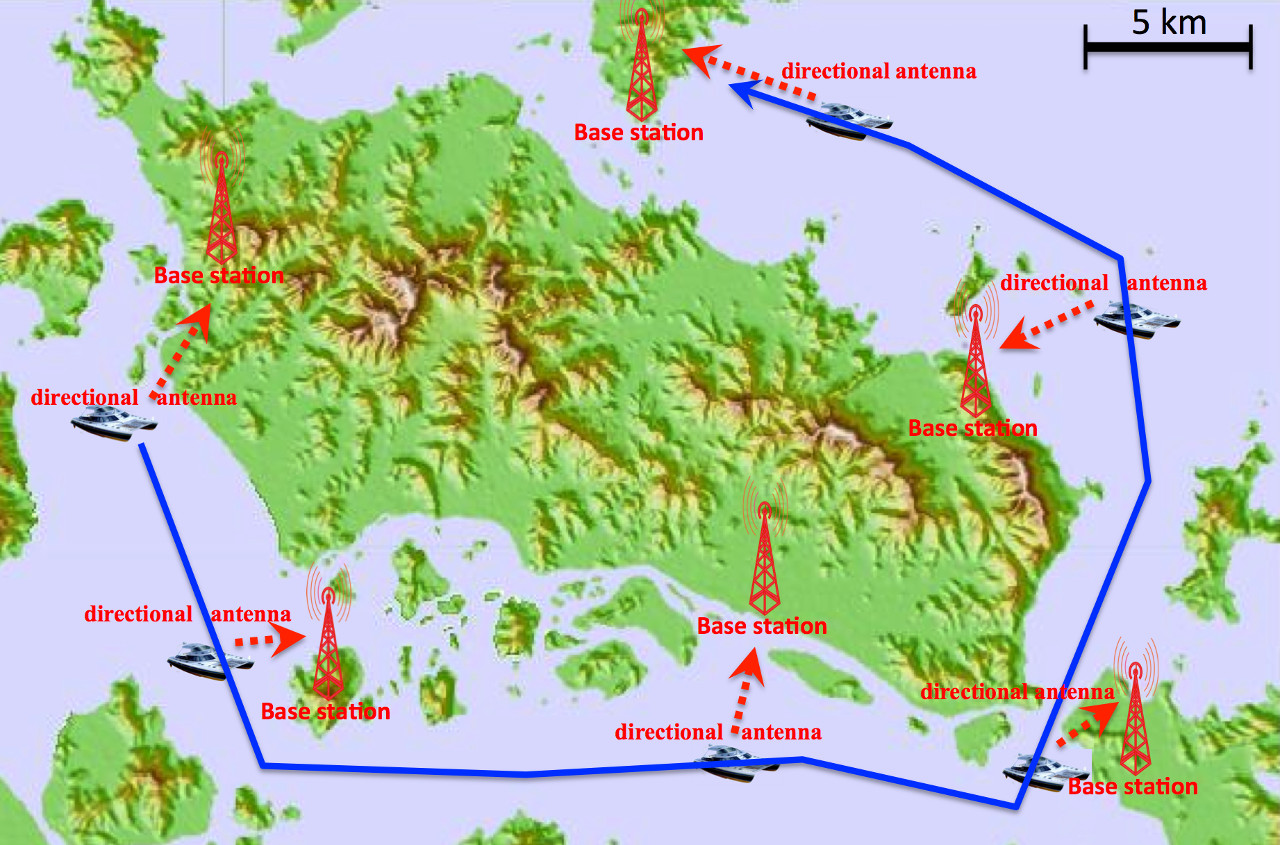
(Left: Unmanned mechatronics) The diagram shows that smart mechatronic systems on an off-shore unmanned platform are controlled by on-shore human operators across long-distance links via high-speed wireless communication.
(Right: Unmanned navigation/unmanned driving) The diagram shows that a unmanned surface vehicle (USV) goes around a charted water region
while it is operated by human operators (not on board) using real-time on-board video+audio feedbacks
via high-speed directional wireless communication. At each position, the USV points its RRTransformer directional antenna
towards the nearest on-shore fixed station. The depicted fixed stations are tetherless stations which do not need utility power lines and
optic fiber cables. High-definition video+audio capture devices installed on board
enable the human operator to see and hear the surroundings of the USV, thus fulfill a safe unmanned navigation.
Nowadays we are the only manufacturer in the world to deliver long-haul broadband link service at 10+km distance for boats
and at 20+km distance for ships. In addition, every vehicle can function as a wireless ad-hoc router to form a long-haul
broadband ad-hoc network covering up to 300 kilometer in diameter or a 70,000 square kilometer water surface area. Likewise, the solution
is also applicable to terrestrial scenarios on land.
We are the only manufacturer in the world who can deliver non-satellite real-time surface broadband MBps IP network service
to moving vehicles over 25km long-haul distance compliant to FCC regulations. Over such long distance,
all other surface-based competitors can only legally deliver MBps broadband IP services to stationary entities,
or Kbps slow rate services to moving vehicles.
If you need high-speed anywhere-anytime IP network service, for example, 10Mbps broadband links to deliver HD video amongst your
automated driving vehicles, or broadband Internet connection for banquet party on your yacht, here is the right place.
Tetherless & Wireless Full-fledged Fixed Station Router
This unmanned broadband fixed station is built on top of our "install-and-forget" technology. It features a 10-sqft ground lot and a less-than-$5000 one-time installation cost. Then it will be self-regulated and self-maintained. Our customers only need to replace the off-the-grid battery every 5 years, the solar panel every 15 years, and the wind turbine every 20 years.The fixed station is a full-fledged ad hoc router that supports RIP, OSPF and OLSR routing protocols.

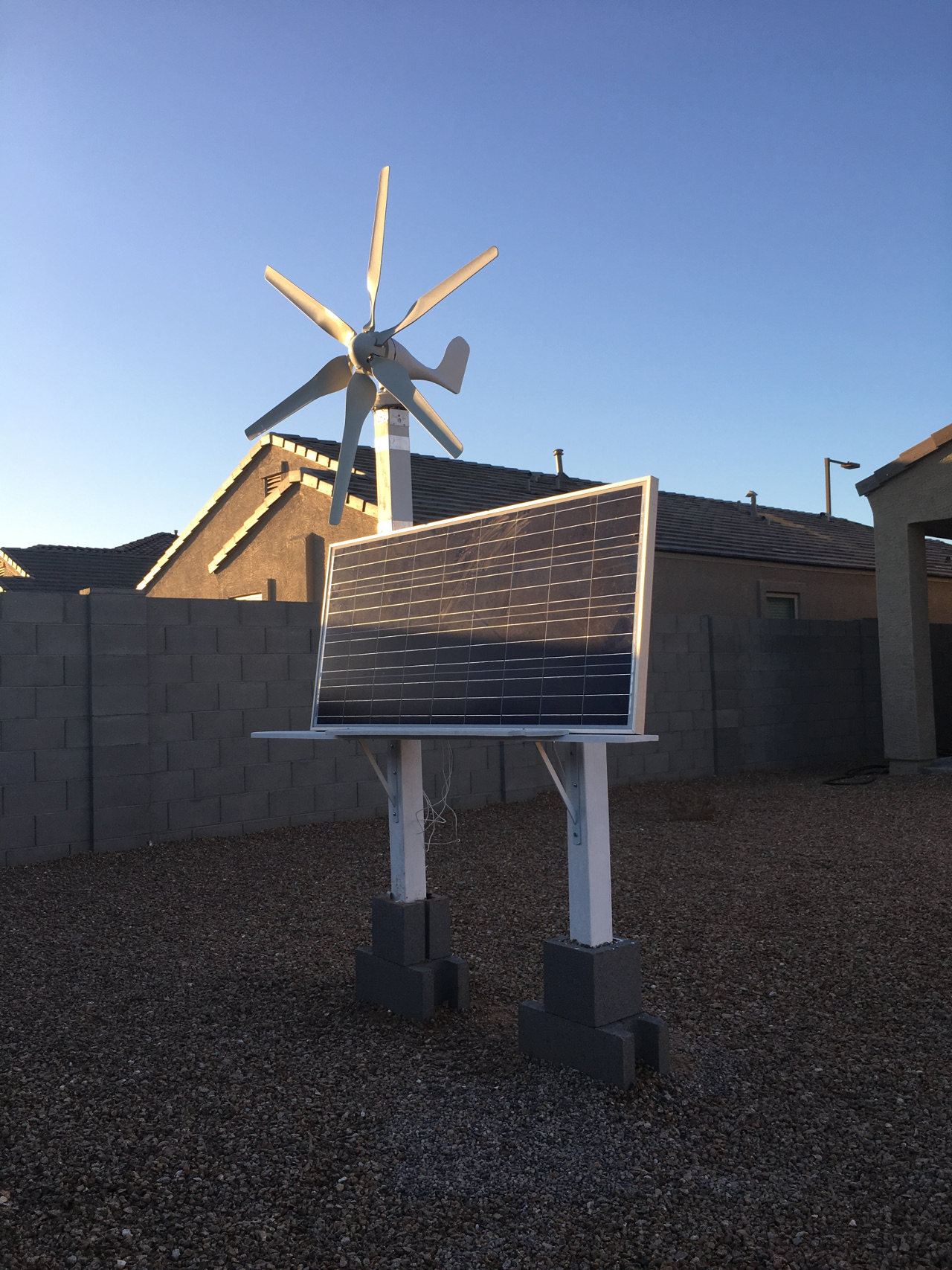
(Left) A tetherless green-powered fixed station in southern California
(Right) A tetherless green-powered fixed station in Arizona
RRTransformer
RRTransformer, or Radio-Rate-Transformer, is an FCC-compliant vehicular communication system that features:- high-speed broadband communication: RRTransformer systems can deliver ~10Mbps broadband data speed at 10 kilometers distance (for RRTransformer10+km system) or 20 kilometers distance (for RRTransformer20+km system);
- portability: RRTransformer can be mounted on any vehicle bigger than toy vehicles.
- RRTransformer10+km (without external radome cover) is 19in x 7in x 10in (0.5m x 0.18m x 0.3m) in Length x Width x Height dimension, 13lb (6kg) in weight.
- RRTransformer20+km (without external radome cover) is 32in x 9in x 13in (0.85m x 0.25m x 0.35m) in Length x Width x Height dimension, 22lb (10kg) in weight.
- multi-hop wireless routing: RRTransformer systems are designed for TCP/IP networks running multi-hop routing protocols. Currently the default routing protocol is RIP, which can be replaced by OSPF, OLSR or B.A.T.M.A.N. upon customer's request. Our network system can cover a large geographical region with up to 300 kilometers in diameter via purely wireless routes, before integrated into the Internet.
Price tags:
(All of our products are manufactured in USA, currently in the state of California)
- RRTransformer10+km price is US$5,900 (rain-proof only, without maritime radome), US$7,900 (with 24-in maritime radome).
- RRTransformer20+km price is US$12,900 (rain-proof only, without maritime radome), US$15,900 (with 38-in maritime radome).
Pictures of an RRTransformer10+km system inside a 24-in radome:
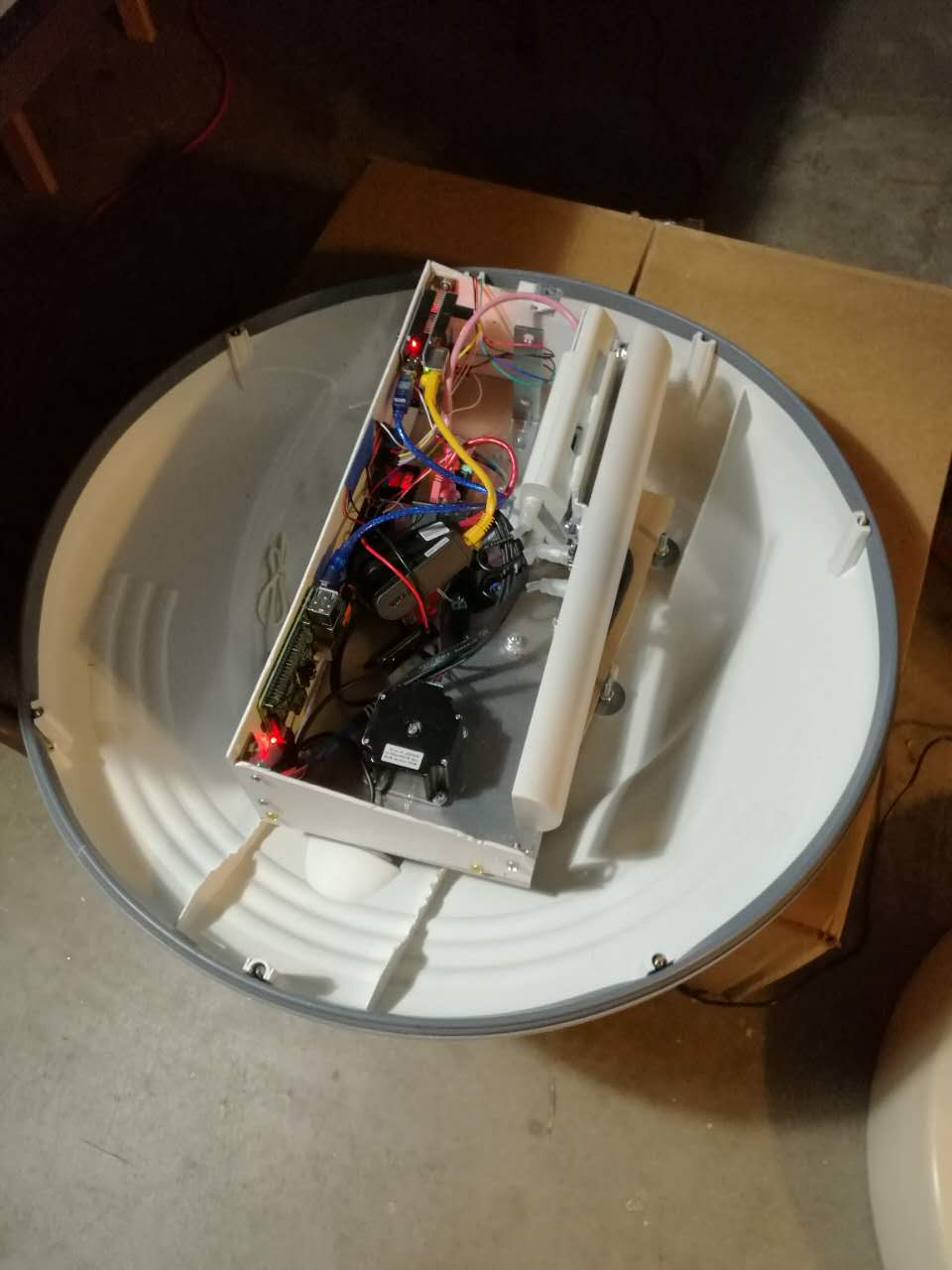
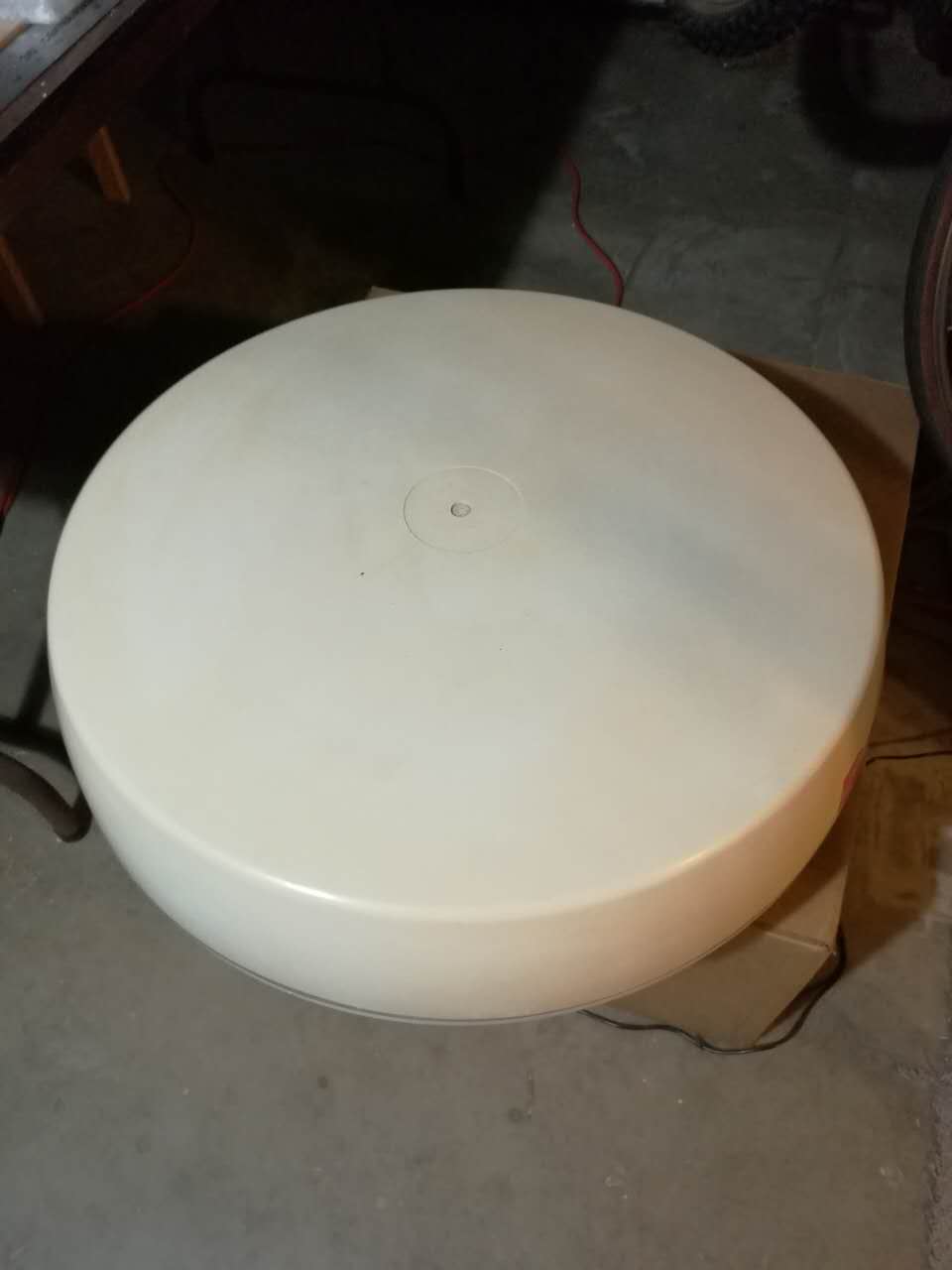
Demo videos:
- An RRTransformer doing yaw-rotation at angular speed of 60 degrees/second (~1 radian/second).
- Another RRTransformer doing yaw-rotation at angular speed of 180 degrees/second (~3 radians/second).

|

|

|
|||||
|---|---|---|---|---|---|---|---|
| Device Model | KVH TracPhone V11-IP | KVH TracPhone V7-IP | KVH TracPhone V3-IP | RRTransformer20+km | RRTransformer10+km | RRTransformerlightweight 10+km | RRTransformer-foolproof |
| Service Provider |

|
IEEE 802.11 standard PCF & DCF scheme |
|||||
| Service | KVH mini-VSAT Broadband Airtime | Surface Wireless Ad-hoc Network | |||||
| Antenna Type | Dual-mode C/Ku-band | Ku-band | 802.11a & 802.11g bands | ||||
| Belowdecks Equipment | Integrated CommBox Modem (ICM) | Gigabit Ethernet & Layer-3 Switch | |||||
| Service Coverage Area | Global except Arctic Regions | Seamless Worldwide Regions |
20km offshore per hop; 300km offshore multi-hop |
10km offshore per hop; 150km offshore multi-hop |
7km per hop | ||
| Maximum Download Speed | 4 Mbps | 3 Mbps | 2 Mbps |
10 Mbps per pair of devices, up to 150 Mbps per pair of sites |
|||
| Maximum Upload Speed | 1 Mbps | 512 Kbps | 128 Kbps |
10 Mbps per pair of devices, up to 150 Mbps per pair of sites |
|||
| Billing Method |
Metered (M) US$1.99/MB, Open (OP): monthly fee ≥ US$799, Fixed (FX): monthly fee ≥ US$1199 |
Metered (M) US$1.99/MB |
None |
||||
| Typical Cost per Minute for Voice (see rate sheet) | Starting at $0.05 USD (speed-based plans) | Starting at $0.05 USD (speed-based plans) $0.49 USD (metered plans) |
$0.49 USD |
None (unlimited free traffic) |
|||
| Antenna Dish Diameter | 1.1 m (42.5") | 60 cm (24") | 36.8 cm (14.5") | 70 cm (29.5") | 36.7 cm (14.5") | 34 cm (13") | 34 cm (13") |
| Antenna Unit Diameter x Height/Weight | 1.2 m (D) x 1.4 m (h) / 109 kg (48.8" (D) x 57.3" (h) / 240 lbs) | 66.3 cm (D) x 79.2 cm (h) / 26.1 kg(26.1" (D) x 31.2" (h) / 57.6 lbs) | 39.4 cm (D) x 44.7 cm (h) / 11.3 kg (15.5" (D) x 17.6" (h) / 25 lbs) |
72 cm (D) x 20 cm (h) / 10 kg 28 in (D) x 8 in (h) / 10 kg w/o cover 81 cm (D) x 30 cm (h) / 15 kg 32 in (D) x 12 in (h) / 15 kg in DISHBlend radome cover |
43 cm (D) x 16.5 cm (h) / 5 kg 17 in (D) x 6.5 in (h) / 5 kg w/o cover 60 cm (D) x 23 cm (h) / 8 kg 23 in (D) x 9 in (h) / 8 kg in Raytheon M92652 radome cover |
34 cm (L) x 20cm (W) x 13 cm (h) / 2.8 kg |
34 cm (L) x 25cm (W) x 25 cm (h) / 3 kg |
| Price | US$ 61,000 | US$ 31,500 | US$ 14,000 | US$ 12,900 per unit | US$ 5,900 per unit | US$ 4,900 per unit | |
| Primary Market | Consumer users. | Enterprise users with landbased Internet gateway. | |||||
| Man on-board vehicles with local human operations | Unmanned vehicles under human-in-the-loop remote control with high-definition video+audio feeds at real time, for instance, in a vehicular swarm robotics scenario | For mobile vehicles to connect to fixed base stations, there is little need of calibration and user configuration. | |||||
Another similar system, Kongsberg's MBR claims to have a non-publicly-priced directional MBR 189 system.
- MBR 189 is illegal in USA because its transmission power (36dBm Tx + 24dBi Antenna = 60dBm EIRP) is several times exceeding the max limit allowed by FCC even for stationary transmitters (30dBm Tx + 23dBi Antenna = 53dBm EIRP), let alone mobile transmitters (30dBm Tx + 6dBi Antenna = 36dBm EIRP).
- Unlike RRTransformer and MBR 189 using directional antennas, MBR 179 and MBR 169 claim to use omni-directional antennas.
- The technical parameters, in particular the transmission range and link bitrate, are false claims. A digital radio expert can confirm the fallacy in MBR 179's datasheet (so-called 45km operational range) and MBR 169's datasheet (so-called 35km operational range).
- In addition, MBR 179 is illegal in USA because its transmission power (36dBm Tx + 21dBi Antenna = 57dBm EIRP) is several times exceeding the max limit allowed by FCC (30dBm Tx + 23dBi Antenna = 53dBm EIRP).
| Kongsberg | Turing Network Test L.L.C. | ||||
|---|---|---|---|---|---|
| Device Model | MBR 189 | MBR 179 | MBR 169 | RRTransformer | |
| Transmission power before antenna |
=4 Watts (36dBm), illegal in USA |
=1 Watt (30dBm), FCC-compliant | ≤ 1 Watt (30dBm), FCC-compliant | ||
| Transmission power EIRP |
=60dBm, illegal in USA |
=57dBm, illegal in USA |
=51dBm, FCC-compliant for fixed scenarios, illegal for moving vehicles | ≤ 53dBm for fixed scenarios, ≤ 36dBm for moving vehicles, both are FCC-compliant | |
| Antenna Type | MBR Document Page claims to be directional | MBR Document Page claims to be omni-directional | Sector directional | ||
| Anti-shaking Capability (Tolerance of underlying vehicle's motions) | Unknown |
|
|||
| Primary Market | Large vessels with crews | Unmanned vehicles under human-in-the-loop remote control with high-definition video+audio feeds at real time, for instance, in a vehicular swarm robotics scenario | |||
- E-mail: jiejun.kong@turingnetworktest.com or james.j.kong@turingnetworktest.com
- Website: http://www.turingnetworktest.com/ (In China you may have to use http://www.turingnetworktest.com:10080 because the Great Firewall of China sometimes blocks the port 80 of our website)
- HAM radio: My call-sign is KM6JNN.
